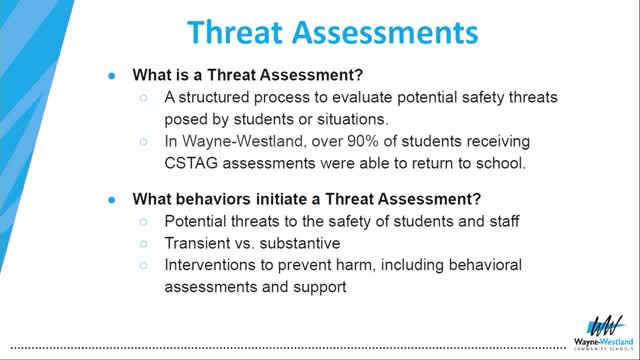Schools Implement Urgent Threat Assessments to Ensure Student Safety
October 10, 2024 | Wayne-Westland Community School District, School Boards, Michigan
This article was created by AI summarizing key points discussed. AI makes mistakes, so for full details and context, please refer to the video of the full meeting. Please report any errors so we can fix them. Report an error »

In a recent government meeting, officials discussed the implementation and effectiveness of the CSTAG (Comprehensive School Threat Assessment Guidelines) in addressing student threats and mental health concerns within schools. The CSTAG, introduced in 2008, has allowed schools in the Wayne Westland district to assess threats more efficiently, enabling over 90% of students who undergo the assessment to return to school promptly, often within an hour, rather than missing several days while waiting for committee evaluations.
The meeting highlighted the district's commitment to mental health, with officials detailing a comprehensive review of their risk assessment processes conducted over the summer. This included the adoption of the Columbia Suicide Severity Rating Scale, an evidence-based screener now used to evaluate students' mental health risks. Training for mental health staff was provided by the creators of the screener, ensuring that assessments can be conducted effectively on-site.
Data collection on suicide risk assessments was also emphasized, with 47 assessments completed from March to the end of the last school year and 29 completed so far this school year. This data is crucial for identifying trends, such as the increased need for assessments among sixth graders, and for planning targeted interventions and funding for mental health programs.
The district has also established a crisis support team to assist schools during emergencies, providing resources and training for building crisis teams. This includes support for everyday incidents and more serious situations, such as social media threats or grief following the loss of a student or staff member.
Additionally, the meeting addressed the importance of communication tools like the \"Okay to Say\" initiative, which encourages students, staff, and parents to report concerns confidentially. This program has proven effective, with officials noting a strong partnership with local law enforcement, enhancing the district's ability to respond to potential threats swiftly.
Overall, the discussions underscored a proactive approach to student safety and mental health, with a focus on immediate intervention, data-driven decision-making, and community collaboration.
The meeting highlighted the district's commitment to mental health, with officials detailing a comprehensive review of their risk assessment processes conducted over the summer. This included the adoption of the Columbia Suicide Severity Rating Scale, an evidence-based screener now used to evaluate students' mental health risks. Training for mental health staff was provided by the creators of the screener, ensuring that assessments can be conducted effectively on-site.
Data collection on suicide risk assessments was also emphasized, with 47 assessments completed from March to the end of the last school year and 29 completed so far this school year. This data is crucial for identifying trends, such as the increased need for assessments among sixth graders, and for planning targeted interventions and funding for mental health programs.
The district has also established a crisis support team to assist schools during emergencies, providing resources and training for building crisis teams. This includes support for everyday incidents and more serious situations, such as social media threats or grief following the loss of a student or staff member.
Additionally, the meeting addressed the importance of communication tools like the \"Okay to Say\" initiative, which encourages students, staff, and parents to report concerns confidentially. This program has proven effective, with officials noting a strong partnership with local law enforcement, enhancing the district's ability to respond to potential threats swiftly.
Overall, the discussions underscored a proactive approach to student safety and mental health, with a focus on immediate intervention, data-driven decision-making, and community collaboration.
View full meeting
This article is based on a recent meeting—watch the full video and explore the complete transcript for deeper insights into the discussion.
View full meeting
